Euro 2020 will mark Sweden’s seventh appearance in this competition, with their best finish coming at their debut campaign in 1992, where they reached the semi-finals and finished third. Sweden made it to the quarter-finals at Euro 2004, and this, along with their 1992 appearance, is the only time that they have made it out of the group stage. The side will therefore be looking to break this record, and emulate their performance from the 2018 World Cup, where they reached the quarter-finals after qualifying from a group containing Mexico, South Korea and Germany. Janne Andersson has been in charge of the side since 2016, and this group of players is now well-adjusted to his demands and tactics.
THE SQUAD
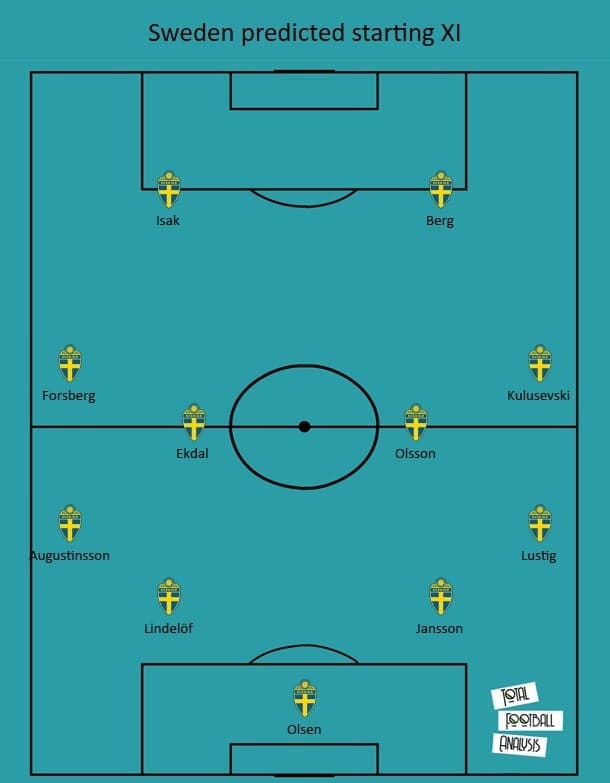
Andersson has preferred a 4-4-2 formation for the majority of his tenure, and this is the shape that Sweden will most likely line up in at Euro 2020 as well.
Robin Olsen will be the man with the gloves, with Karl-Johan Johnsson and Kristoffer Nordfeldt as backup. At right-back, the 34-year-old Mikael Lustig will be first-choice, while Werder Bremen’s Ludwig Augustinsson will occupy the left-back berth. Emil Krafth and Martin Olsson offer experienced backup options for these positions. Manchester United’s Victor Lindelöf is likely to be partnered by Brentford captain Pontus Jansson, with Andreas Granqvist unlikely to start despite being the captain of the side.
Kristoffer Olsson and Albin Ekdal will form the midfield duo, while the Swedes have two excellent options on the flanks, in Juventus’ Dejan Kulusevski, and RB Leipzig’s Emil Forsberg. The veteran Sebastian Larsson is part of the squad, with Viktor Claesson and Mattias Svanberg as options on the bench too.
Having announced his return from international retirement for this tournament, it came as a blow that Zlatan Ibrahimović misses out due to injury. In his absence, Marcus Berg and Alexander Isak should start as the strike pair, with Robin Quaison and Jordan Larsson in reserve. Larsson is of course the son of Sweden and Celtic legend Henrik Larsson, and it will be interesting to see if he gets a chance to emulate his father’s achievements at this tournament.
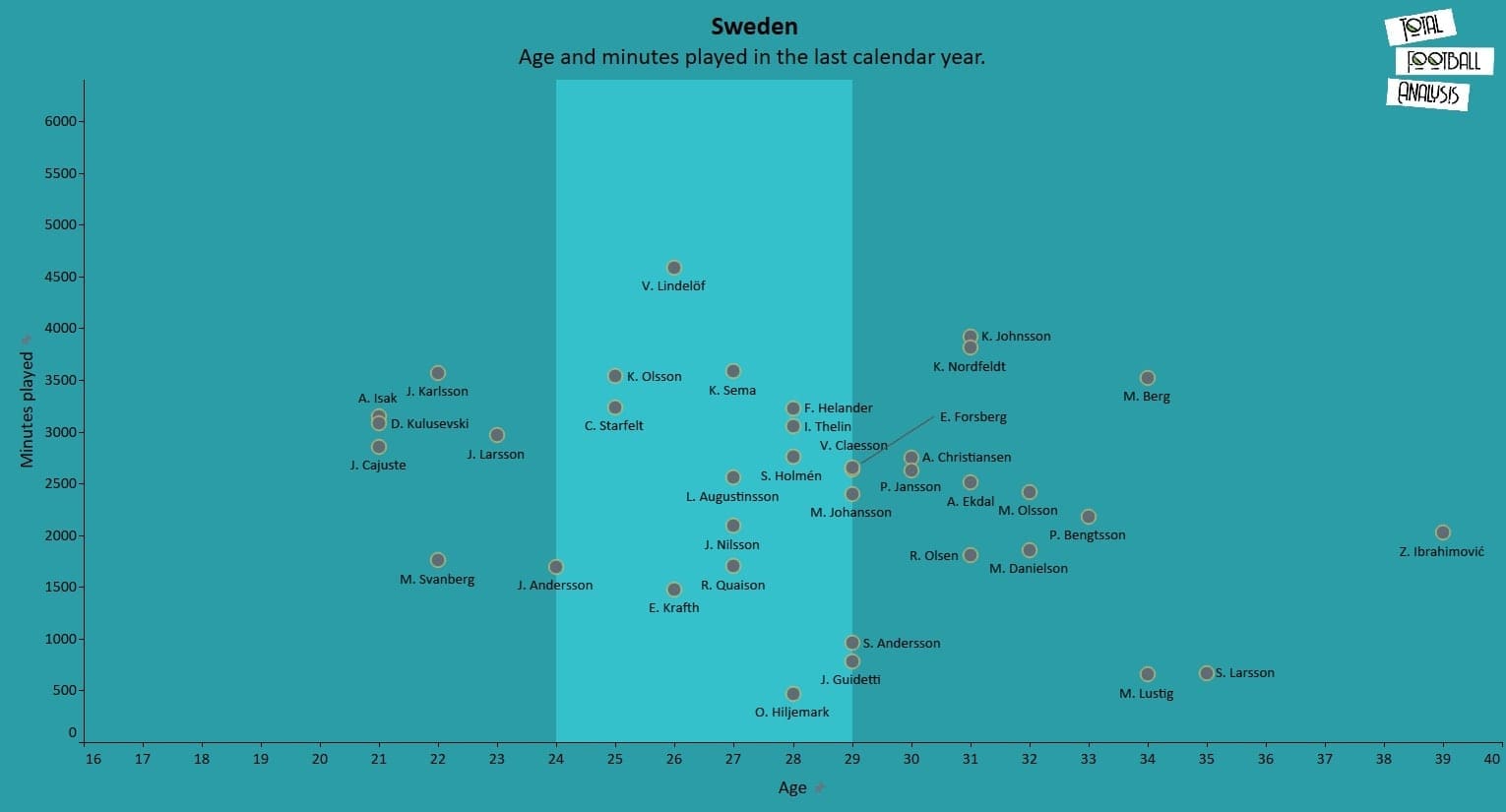
In terms of age profile, we can see that Sweden have an experienced and old squad, with a number of players well above the age of 30 who could yet play important roles, such as Lustig, Granqvist, Olsson, Seb Larsson, Gustav Svensson, and Berg. There are some key players operating at their peak, with the likes of Kulusevski adding some youthful dynamism. This mix of experience and youth could be vital, since the older players all have a lot of caps and can help guide the younger players with regard to their tournament experience.
ATTACKING PHASE
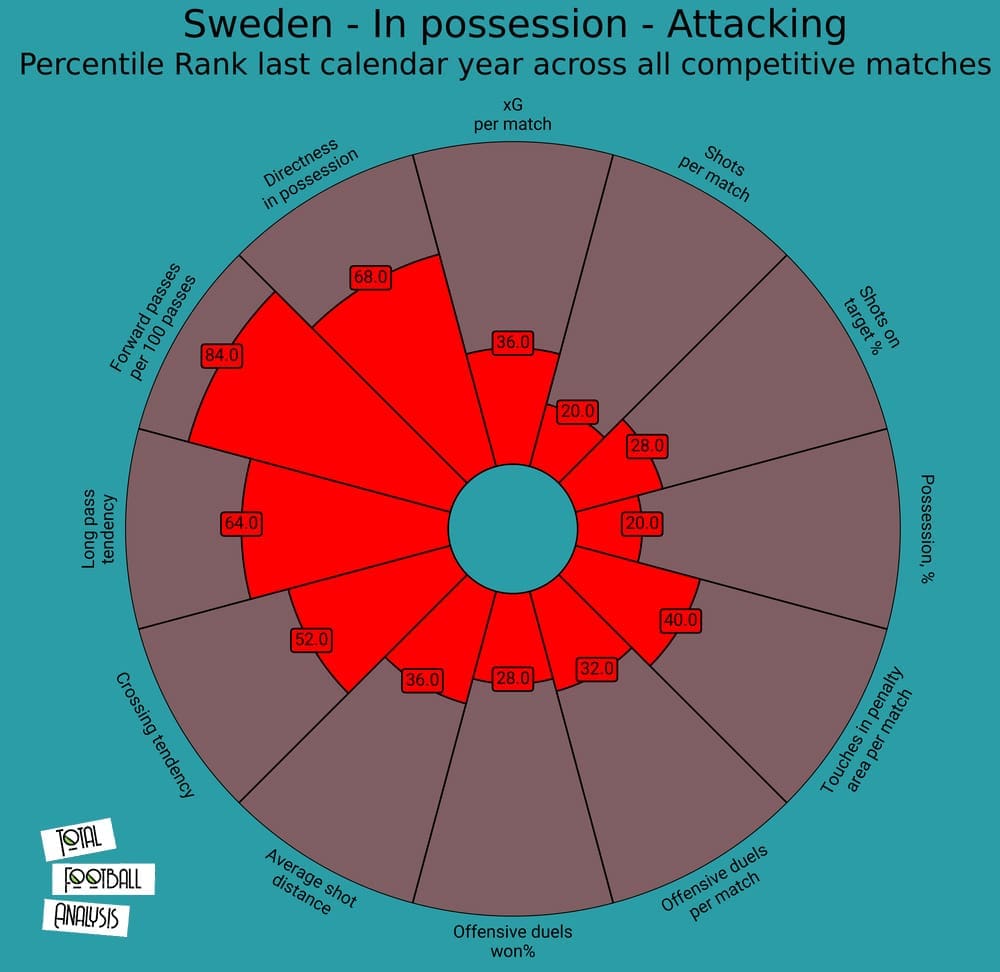
We can immediately gauge from this radar that Sweden are not a side that tries to dominate possession. Sweden’s 4-4-2 shape under Andersson is built to attack quickly and in a direct manner, as we can see from their ranks for possession % (20th percentile), forward passes per 100 passes (84th percentile), long pass tendency (64th percentile), and directness in possession (68th percentile). However, they do struggle to create too many goalscoring opportunities, with low ranks for xG per match, touches in the penalty area, shots, and shots of target %. This means that Sweden will probably have to be extremely efficient and clinical in scoring the few chances that they do create, and thus Ibrahimović’s absence will be keenly felt.
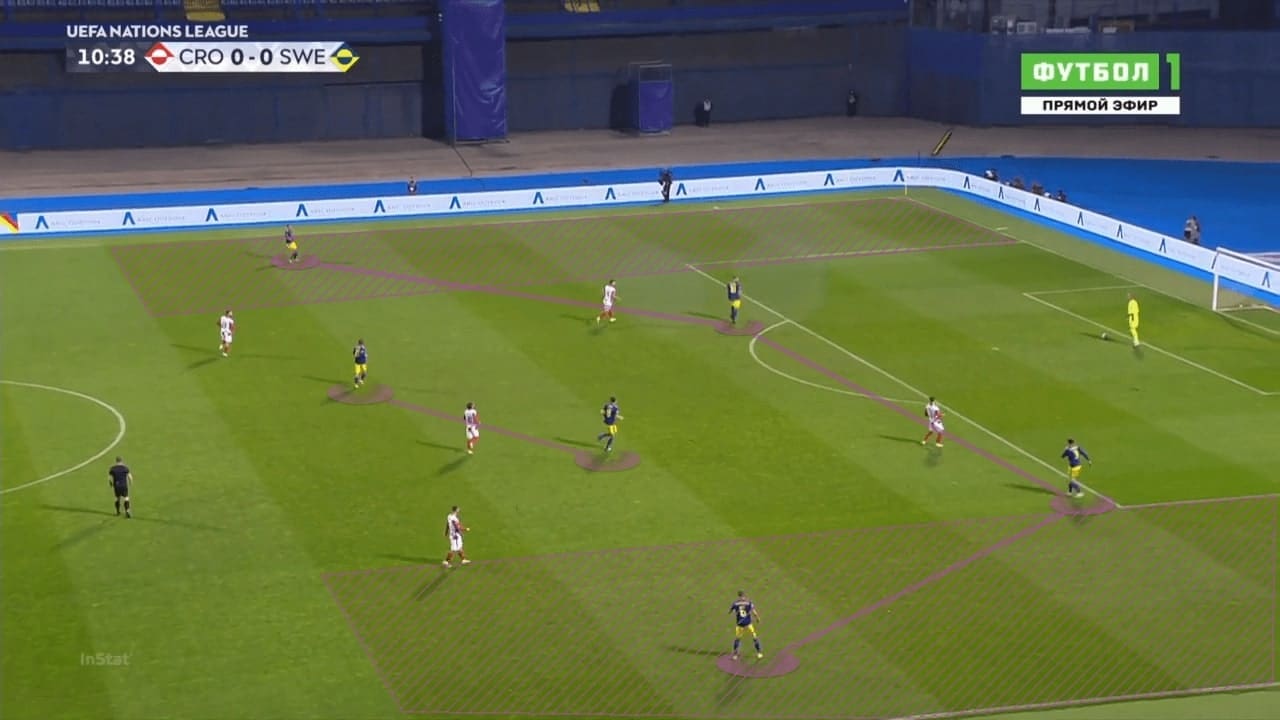
In their first phase of possession, Sweden use a pair of deep and wide full-backs to hold width and stretch the pitch, as we can see in the image. This is to give the central players passing options out wide to escape the opposition press, and also give the goalkeeper and centre-backs the option to hit direct long balls out wide if necessary.
The two midfielders in Sweden’s 4-4-2 shape also stay central and deep to help in the build-up. However, neither Ekdal nor Kristoffer Olsson is particularly progressive midfielders, and this limits their central progression and usually means that they try to progress upfield via the flanks. Lindelöf’s ball-playing ability is crucial here, as he often steps up and tries to influence the build-up through his passing and ball-carrying ability from centre-back.
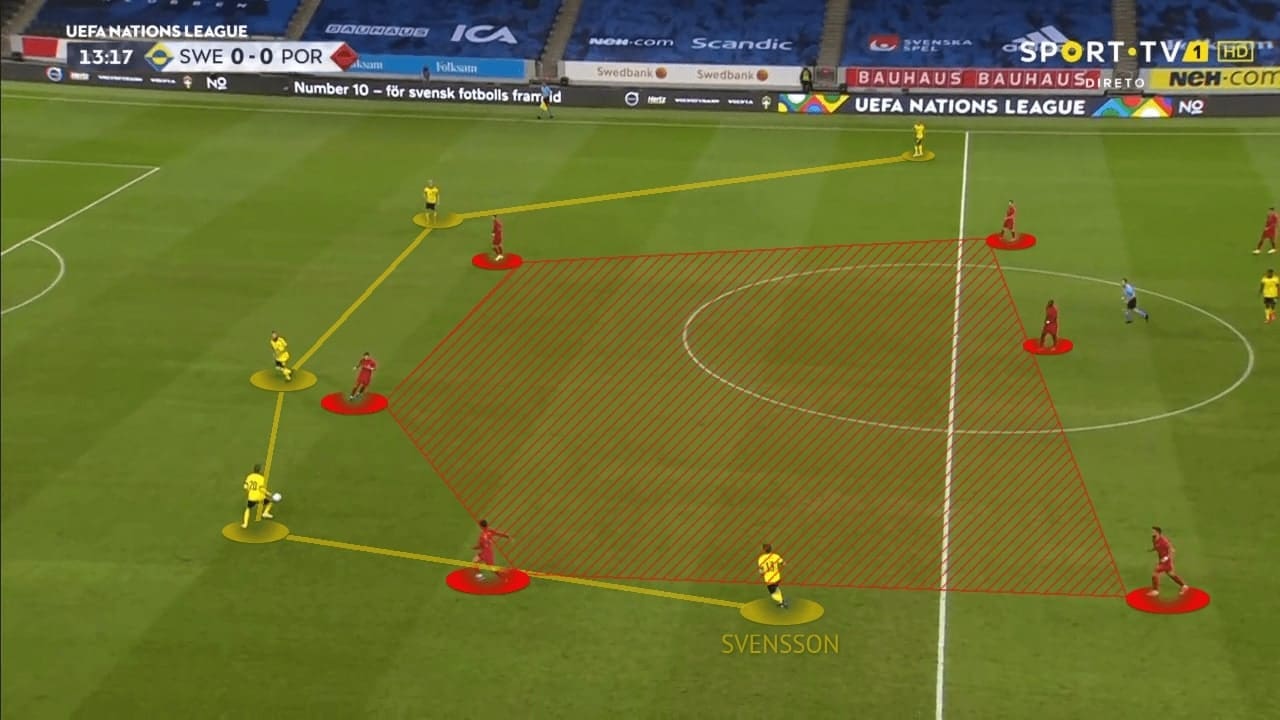
One of the issues with this shape for Sweden is that they are fairly rigid, and therefore players do not always move to pick up space when others move out. We can see an example of this from the game against Portugal, where the centre of the pitch has been completely vacated, with nobody dropping deep or coming infield. This often means that there are no options to pass the ball in these areas, and makes it easier for the opposition to press. It is also perhaps another reason why Sweden usually play a more direct style of football, eschewing short passing since they try to progress from wide areas rather than centrally.
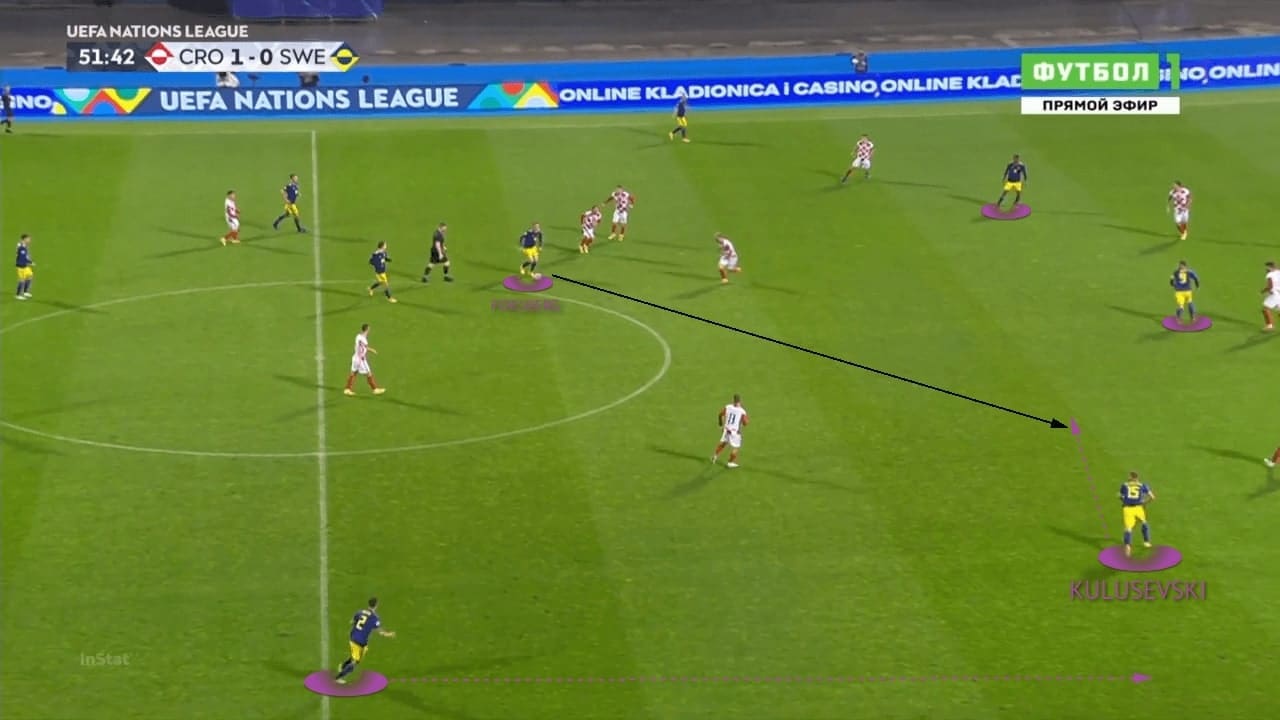
Sweden’s shape morphs into a 4-2-2-2 in their second phase, where the wingers come infield to operate in the half-spaces, and width is provided by the full-backs. This can be seen in the image, where Kulusevski and Forsberg have both moved into central areas, and Lustig will overlap on the right to maintain width. Forsberg will often drop deep as well, as he does in this example, to compensate for the lack of creativity from Sweden’s central midfielders. The two strikers will try to stay high and push the opposition defensive line back to create space for these players, and also to give them passing options in behind when they do get on the ball.
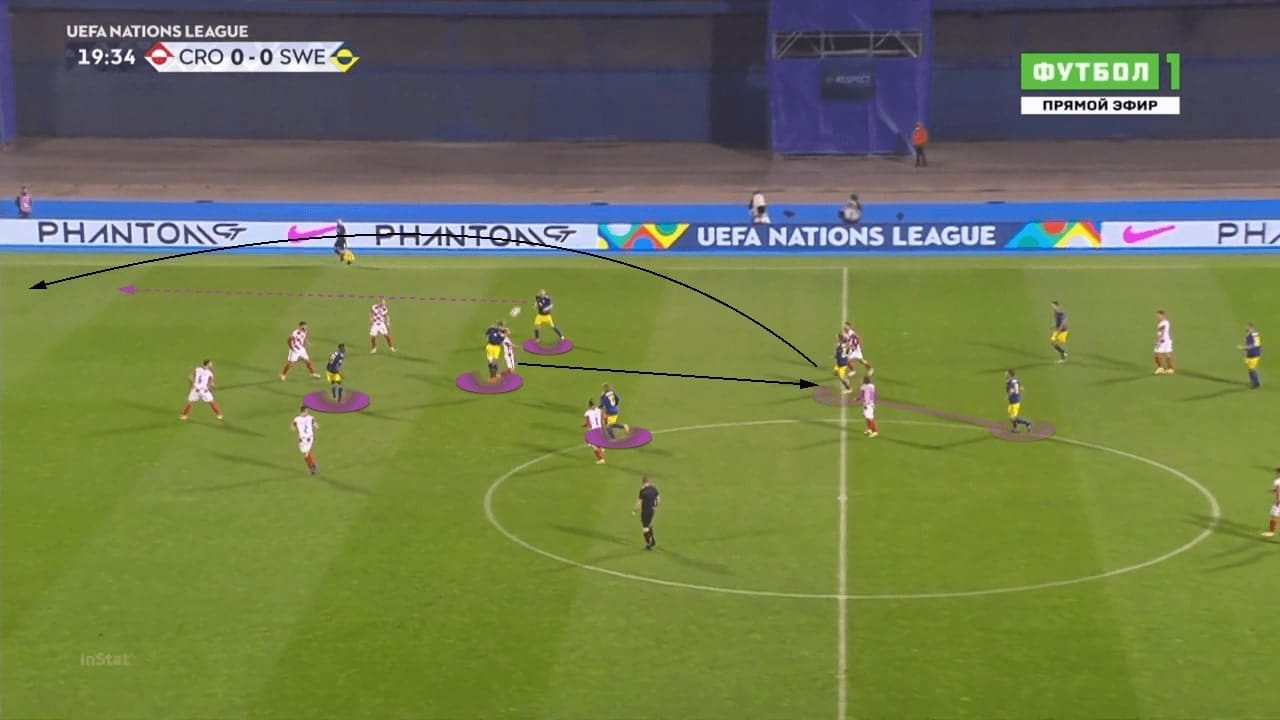
We have already mentioned how the Swedes play in a very direct style in the above analysis, and winning aerial duels and second balls is a key part of their attacking strategy. This is also helped by their attacking structure, with narrow wingers and two central strikers making it easier to win second balls. However, this is another area where Ibrahimović’s absence is sure to be felt, as the AC Milan striker is excellent in the air. In his absence, Berg will be the likely target for long balls from deep, with the likes of Isak, Kulusevski and Forsberg looking to latch onto flick-ons and otherwise pick up possession in advanced areas after he wins the ball. The image shows how Sweden’s attacking players stay central and close to each other to facilitate their direct style of play.
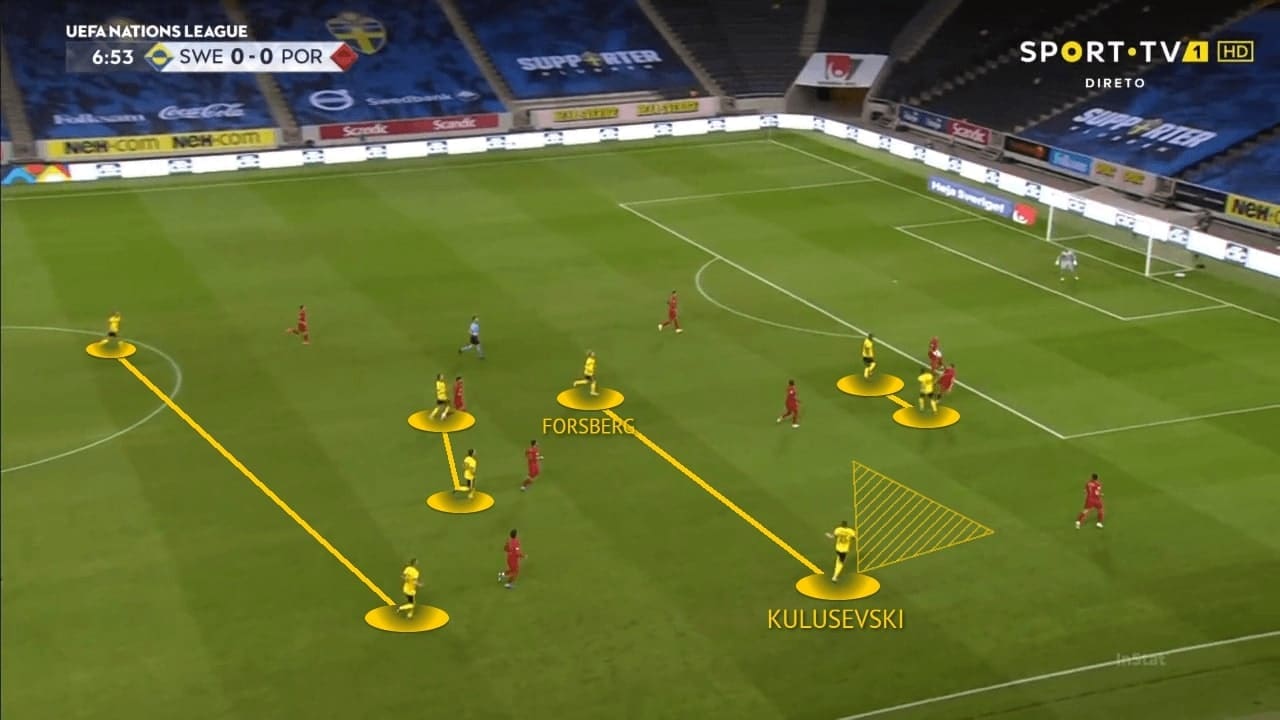
This image shows Sweden’s unique structure which they adopt at times when utilizing a more direct style of play. It is almost a 2-2-2-2 shape, with the three advanced lines of players all close to each other horizontally and vertically to offer a lot of coverage, while this shape also makes it easy to counter-press immediately if possession is lost.
DEFENSIVE PHASE
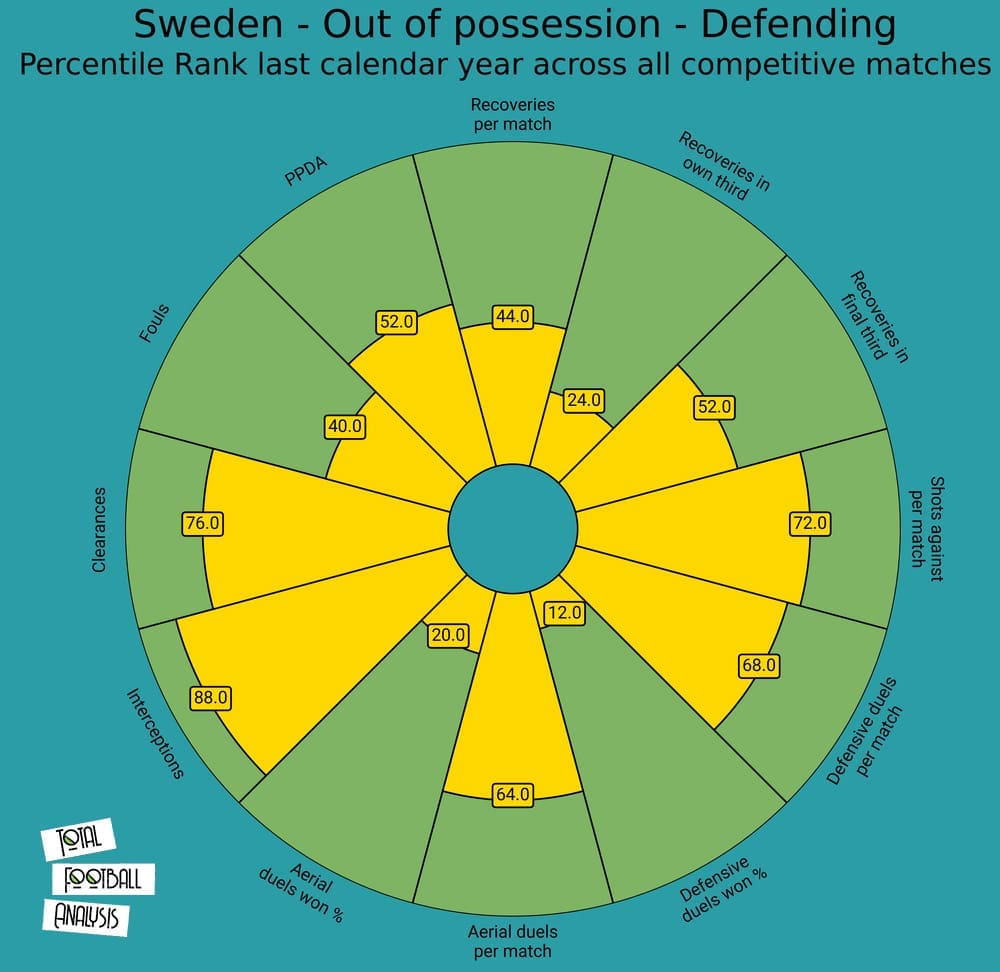
Sweden are quite an active side when defending, as seen from their ranks for interceptions (88th percentile), clearances (76th percentile), defensive duels (68th percentile) and aerial duels (64th percentile). This also shows their approach – Sweden usually defend in a compact block, happy to deal with crosses, while also being proactive at winning the ball back in a physical manner. They are above average for PPDA, indicating a moderately intensive press, while they also prefer to counter-press and attempt to win the ball back in the opponent’s third (52nd percentile) than in their own third (24th percentile). However, they have been quite leaky over the last year (72nd percentile for shots conceded per match), and this indicates a need to tighten up defensively for this tournament.
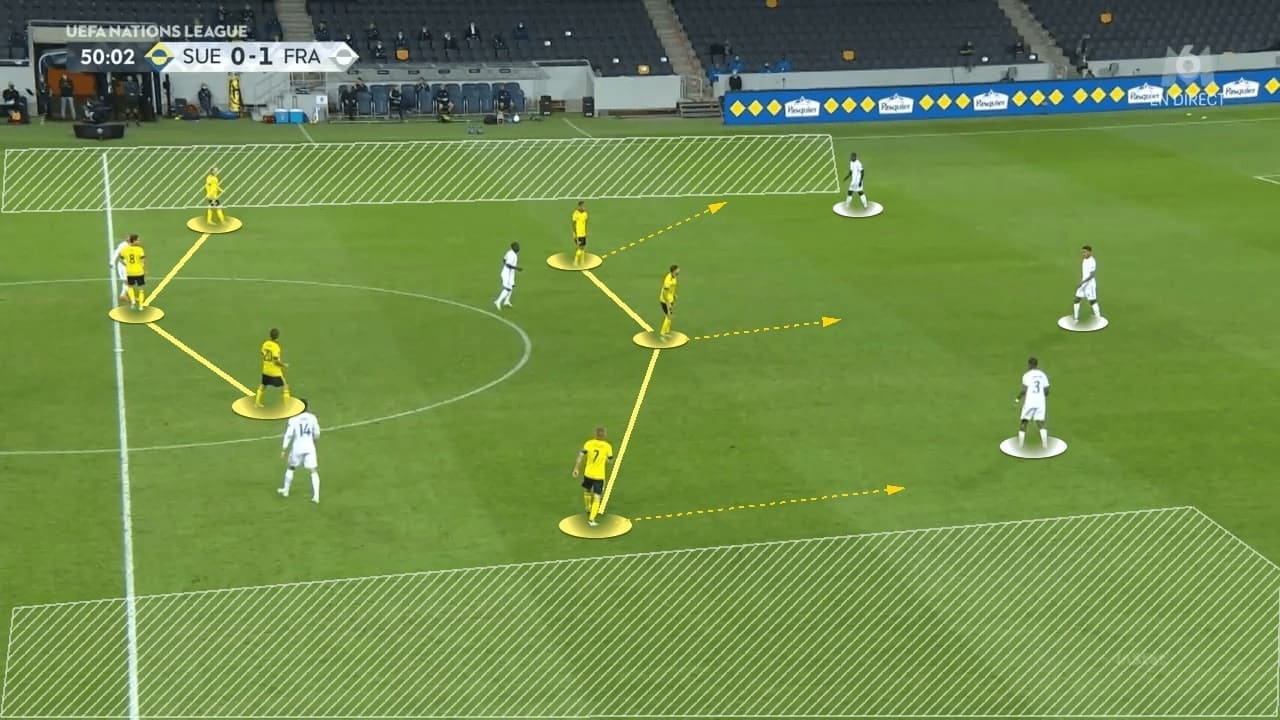
Sweden tend to operate in a mid-block to deny easy central progression for their opponents, as we can see in the image of the tactical analysis. They are flexible and can adopt different shapes off the ball based on the opponent. This image is an example where Sweden’s off-ball shape was a 4-3-3 to counter France’s back three in the build-up phase. Sweden try to have numerical equality or superiority in this zone of the pitch when defending, and as we can see, it would be easy for this front three to now press France’s back three. Of course, this means that Sweden are happy to concede space out wide, as the priority is to deny central progression.
Their 4-4-2 also transforms into a 4-2-2-2 off the ball, with the central midfielders staying deep and central, and the wingers also moving into narrow positions to cut off central progression.
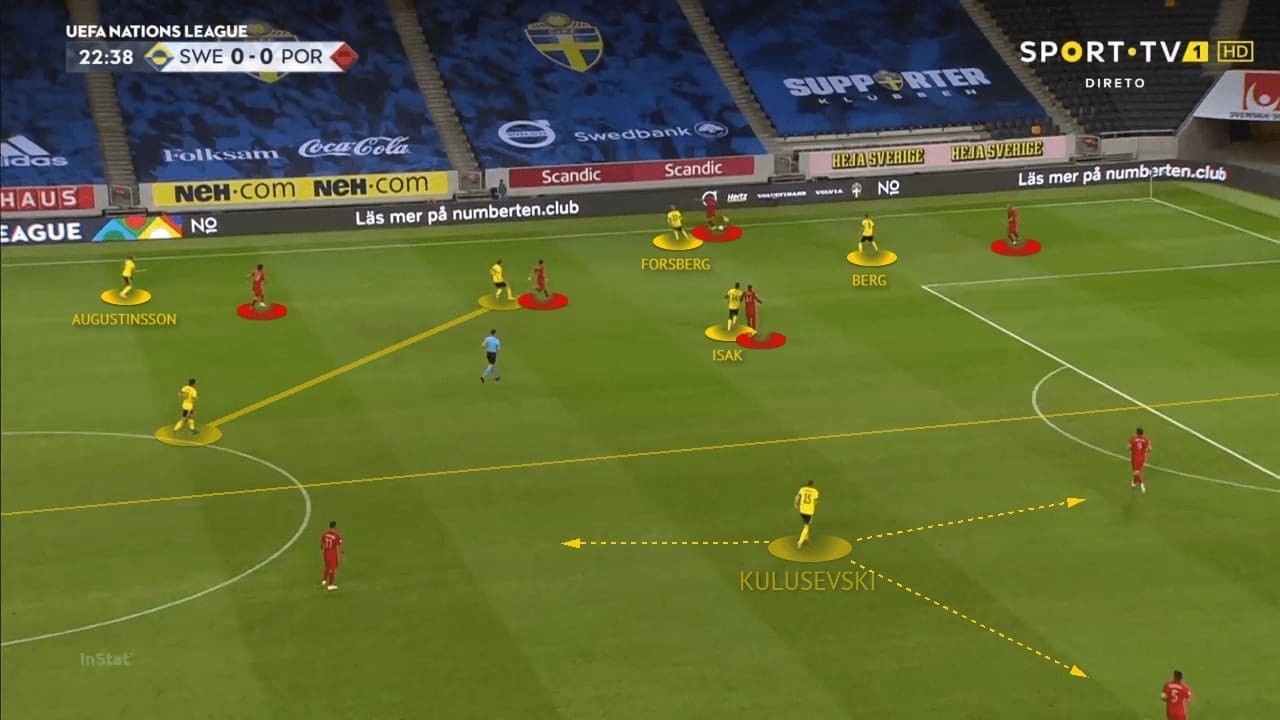
When pressing, Sweden are good at overloading a flank and recovering possession out wide. This image against Portugal is an example where the Swedes have a 6v5 on the ball-side flank, with the full-back also moving high to press, while the far-side winger is in position to press the centre-back or full-back immediately if a switch is made while the rest of the side quickly shifts over. One of the central midfielders stays deep to provide protection, while the other moves high and wide to press and create that numerical superiority.
If the press is bypassed, Sweden shift into a low block, and as mentioned earlier, attempt to close passing lanes centrally and force opponents out wide, where they can again press aggressively, using the touchlines as natural barriers.
TRANSITIONS
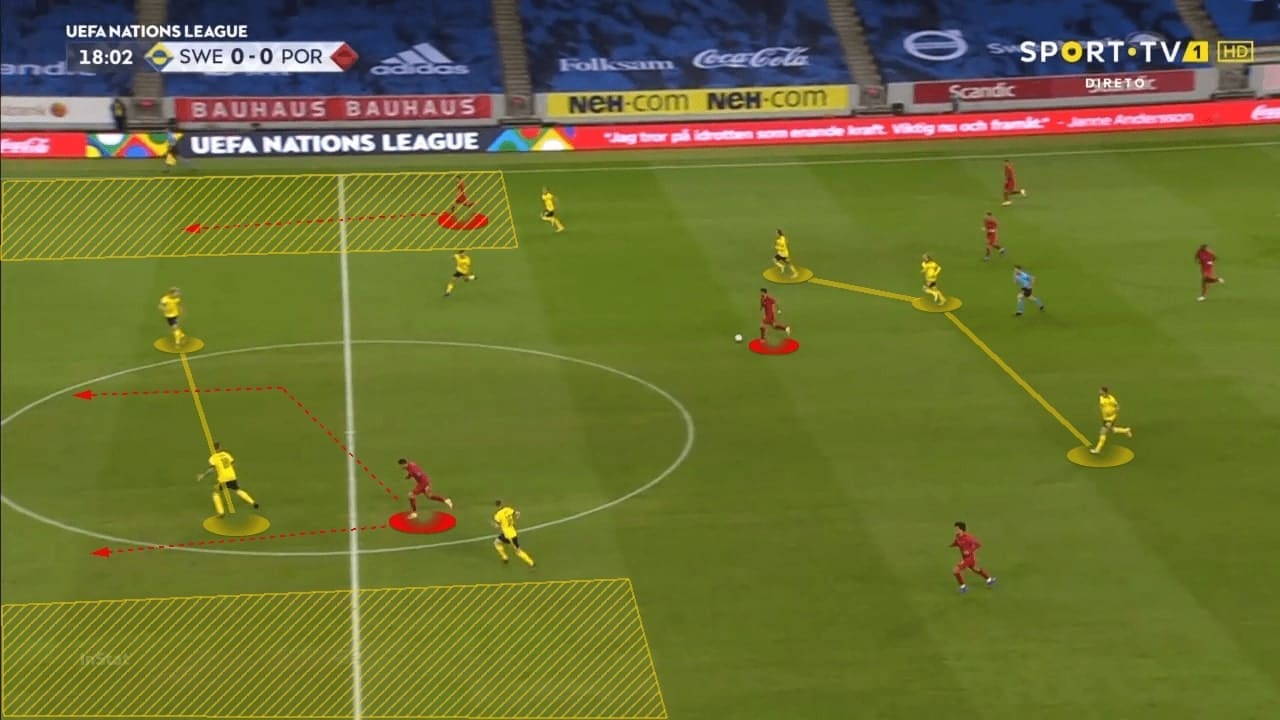
In defensive transitions, Sweden need to be careful to not overcommit players during their attacking phase, which can lead to the sort of situation seen in the next image, where their defence is left isolated.
Here, Sweden conceded space out wide as both full-backs were higher up to support the attack. The centre-backs are therefore left exposed when one of the central midfielders gave possession away, unable to step up due to the amount of space available behind.
Sweden’s direct style of play also lends itself to using offensive transitions to create chances. Berg offers a physical presence upfront to win the ball in the air, with Forsberg and Kulusevski capable of running into space and backpedalling opponents at speed. This could be very important against teams that play with a high defensive line, as Sweden would be able to get in behind with just a couple of well-executed passes.
FORWARDS
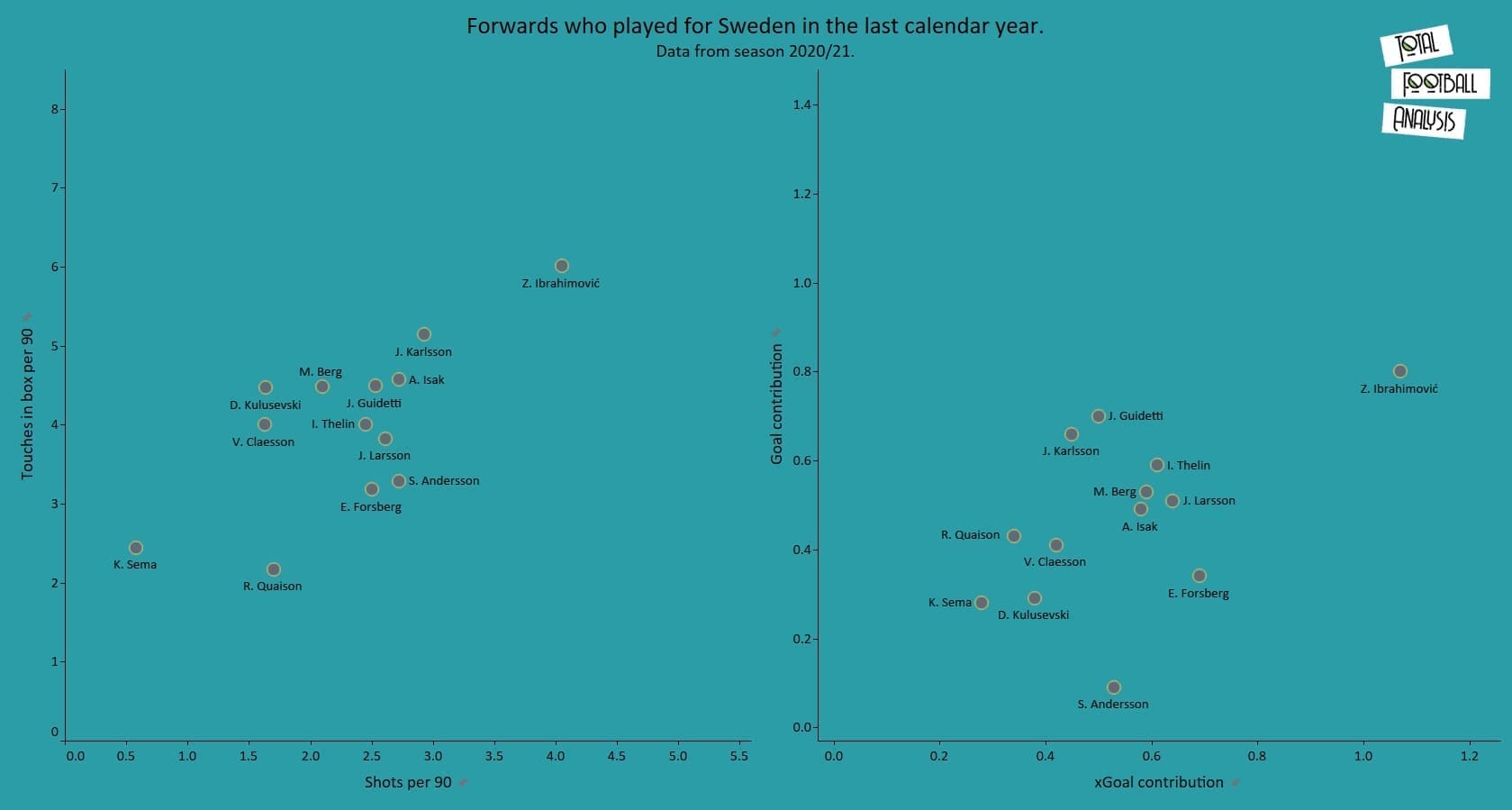
These graphs are a comparison of all the attackers called up by Sweden over the last calendar year. Given Ibrahimović’s absence, Isak is the next-best option in the squad when it comes to involvement in the penalty area and shots, and he has also had a decent goalscoring season for Real Sociedad. Berg is likely to act as a foil for the 21-year-old, concentrating more on winning the ball in the air and laying off possession, since his attacking numbers are not too great.
MIDFIELDERS
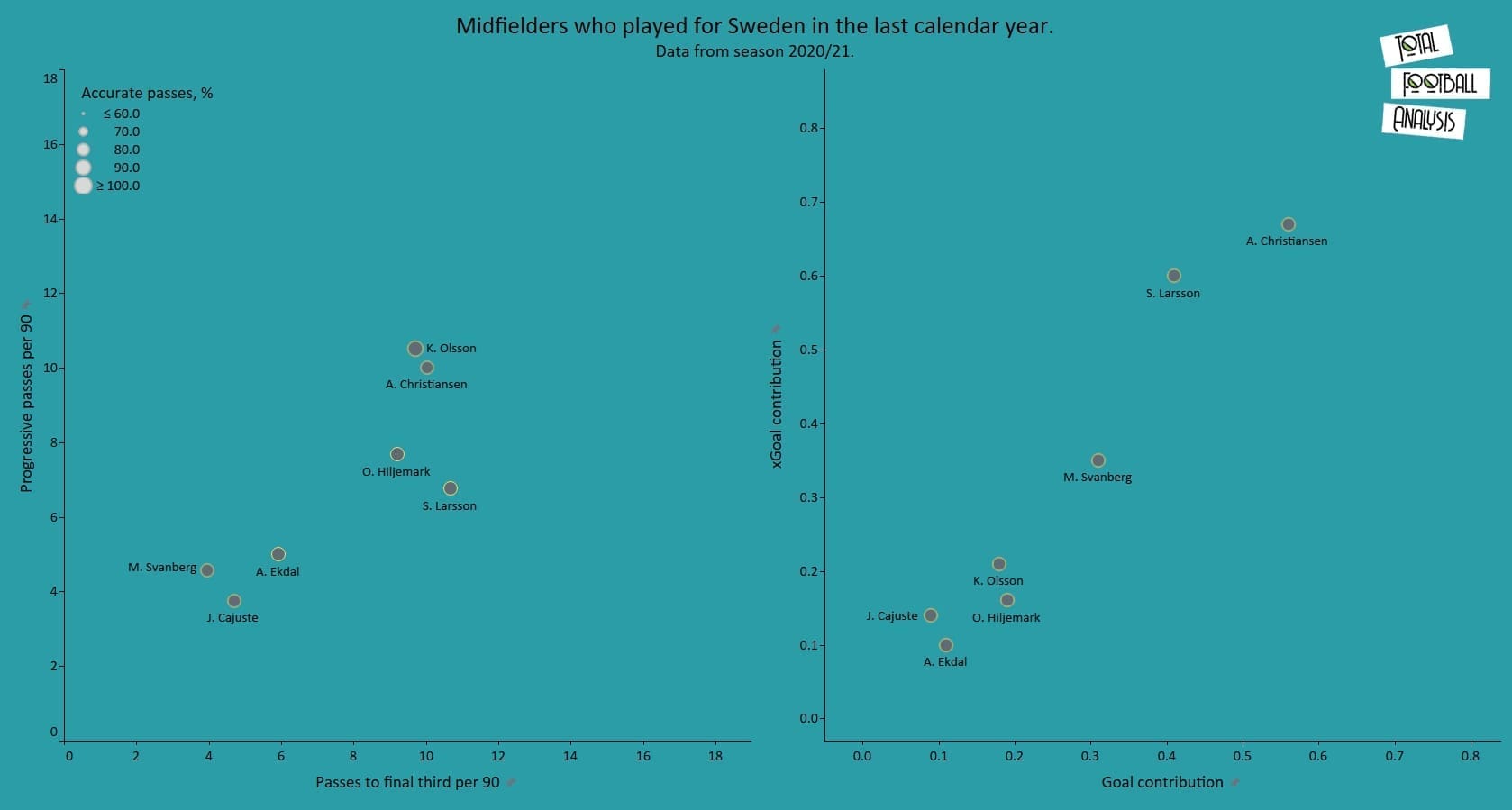
Next, we will look at the Swedish midfielders, where Kristoffer Olsson stands out in terms of creative ability on the left-hand chart. Given the general lack of creativity from the Swedish midfield, he could be an important cog in the wheel in terms of getting the ball forward, with Sebastian Larsson likely to only make an impact off the bench. Larsson is also the midfielder who was most involved in goalscoring as well as setting up chances by far this season – the former Sunderland veteran is excellent from dead-ball situations, and set-pieces are definitely an area that the team will look to exploit when he is on the pitch.
DEFENDERS
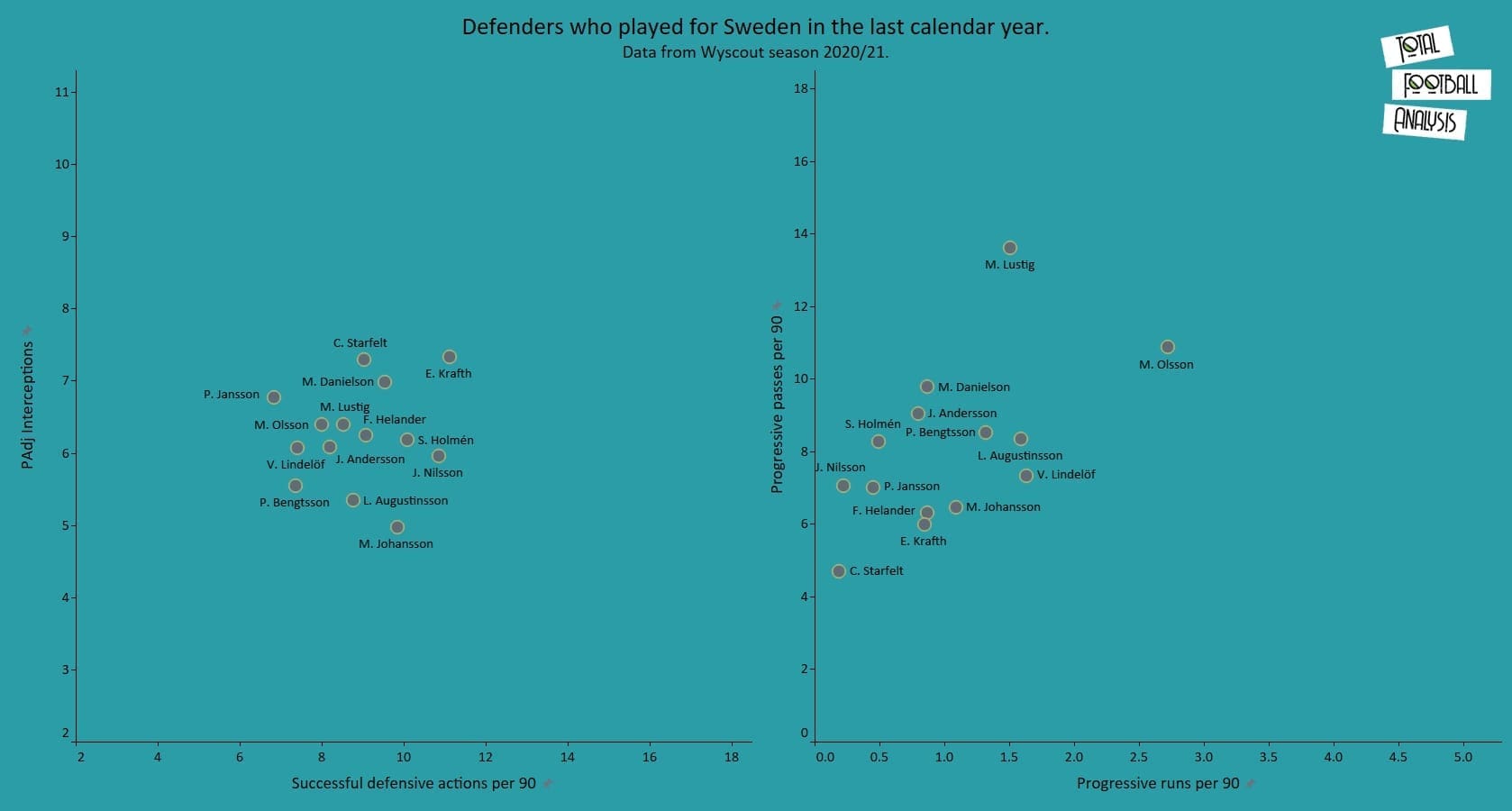
Our last comparison looks at the Swedish defenders, where it is perhaps a surprise to see Newcastle United’s Krafth as one of the best performers on our defensive metrics. There may be a case for him to start over Lustig at right-back at Euro 2020, based on these numbers, while Pontus Jansson is also impressive in terms of his ability to win the ball back via interceptions.
In terms of ball progression, it is the two full-backs, Olsson and Lustig, who stand out. Olsson makes more progressive runs, while Lustig is a better progressive passer, which is an indication of their relative strengths and roles within this Sweden side as well.
BEST PERFORMERS
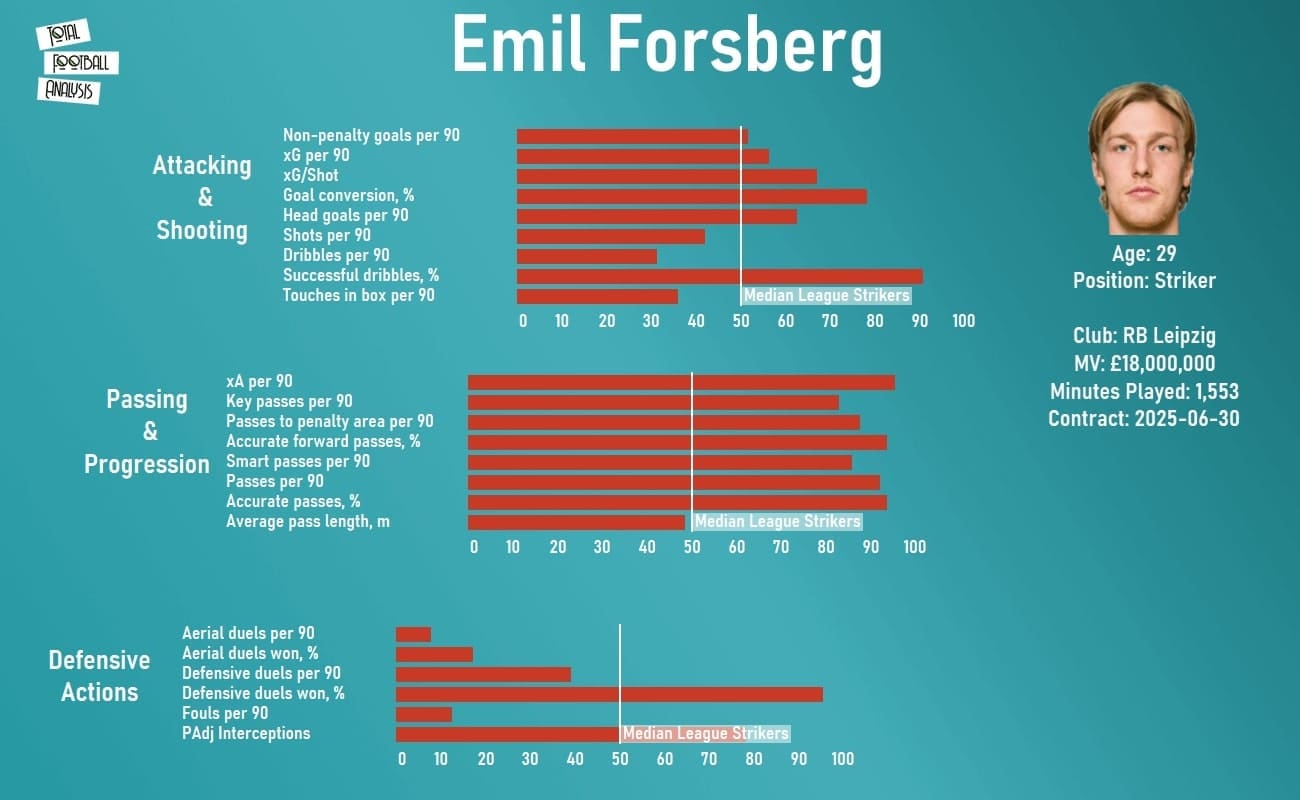
In Ibrahimović’s absence, Forsberg is Sweden’s best player, and his ability to score and create will play a huge role for the side at this tournament. He has years of top-level experience in the Bundesliga and the Champions League for RB Leipzig, and we can see just how influential he will in possession for the side, ranking high for nearly all of our passing and progression metrics.
The 29-year-old once notched 22 assists in a single Bundesliga campaign, and his xA numbers show how he is likely to be Sweden’s chief creator. He is a goal threat himself as well, while also having the ability to get past his opponent in a 1v1 duel when needed. Forsberg will also play a big role in Sweden’s counter-press, having been part of an excellent counter-pressing unit at Leipzig. As we have shown in this scout report, his performances will go a big way towards deciding just how far Sweden can progress at Euro 2020.
PREDICTIONS FOR THE TOURNAMENT
Given the make-up of their group, we expect Sweden to be in the running for second place behind Spain, and they could even sneak into the round of 16 as one of the four best third-placed teams. Croatia could be one of their potential opponents in that round, while they may also face the Netherlands or Belgium if they qualify as one of the third-placed teams. This is probably the limit of their ambitions, and it would take some excellent performances for Sweden to progress any further.
PREDICTED SQUAD LIST
Goalkeepers
Karl-Johan Johnsson
Kristoffer Nordfeldt
Robin Olsen
Defenders
Ludwig Augustinsson
Marcus Danielson
Andrea Granqvist (C)
Filip Helander
Emil Krafth
Pontus Jansson
Victor Lindelof
Miakel Lustig
Martin Olsson
Midfielders
Jens Cajuste
Viktor Claesson
Albin Ekdal
Emil Forsberg
Dejan Kulusevski
Sebastian Larsson
Kristoffer Olsson
Ken Sema
Mattias Svanberg
Gustav Sevensson
Forwards
Marcus Berg
Alexander Isak
Jordan Larsson
Robin Quaison

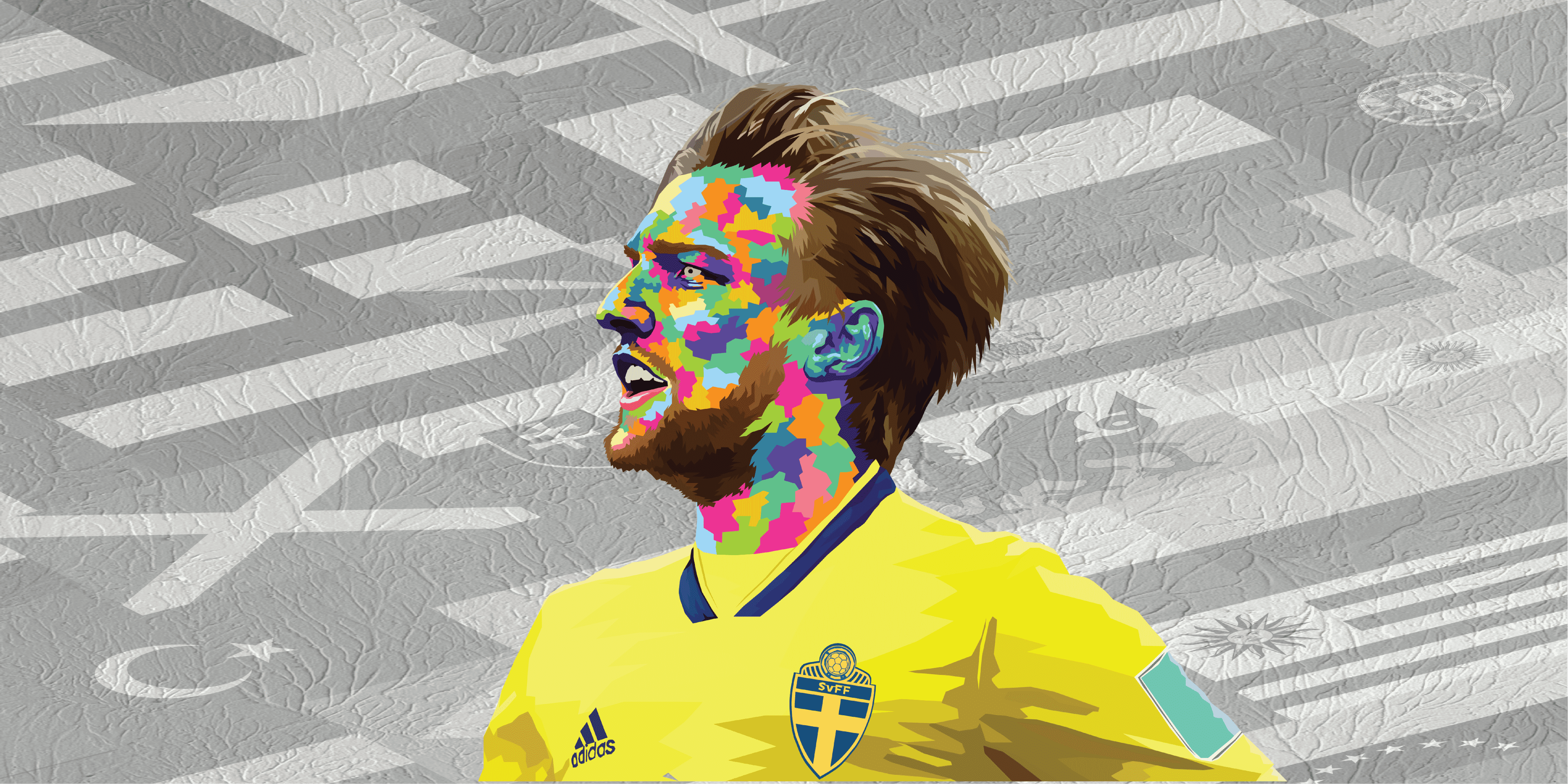



Comments